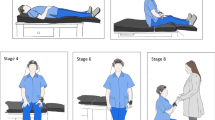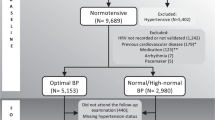Abstract
Methods used for the assessment of cardiovascular reactivity are flawed by nonlinear dynamics of the cardiovascular responses to stimuli. In an attempt to address this issue, we utilized a short postural challenge, recorded beat-to-beat heart rate (HR) and pulse transit time (PTT), assessed the data by fractal and recurrence quantification analysis, and processed the obtained variables by multivariate statistics. A 10-min supine phase of the head-up tilt test was followed by recording 600 cardiac cycles on tilt, that is, 5–10 min. Three groups of patients were studied, each including 20 subjects matched for age and gender— healthy subjects, patients with essential hypertension (HT), and patients with chronic fatigue syndrome (CFS). The latter group was studied on account of the well-known dysautonomia of CFS patients, which served as contrast against the cardiovascular reactivity of the healthy population. A total of 52 variables of the HR and PTT were determined in each subject. The multivariate model identified the best predictors for the assessment of reactivity of healthy subjects vs CFS. Based on these predictors, the ‘Fractal & Recurrence Analysis-based Score’ (FRAS) was calculated: FRAS=76.2+0.04*HR-supine-DET −12.9*HR-tilt-R/L −0.31*HR-tilt-s.d. −19.27*PTT-tilt-R/L −9.42*PTT-tilt-WAVE. The median values and IQR of FRAS in the groups were: healthy=−1.85 (IQR 1.89), hypertensives=+0.52 (IQR 5.78), and CFS=−24.2 (5.34) (HT vs healthy subjects: P=0.0036; HT vs CFS: P<0.0001). Since the FRAS differed significantly between the three groups, it appears likely that the FRAS may recognize phenotypes of cardiovascular reactivity.
This is a preview of subscription content, access via your institution
Access options
Subscribe to this journal
Receive 12 digital issues and online access to articles
$119.00 per year
only $9.92 per issue
Buy this article
- Purchase on Springer Link
- Instant access to full article PDF
Prices may be subject to local taxes which are calculated during checkout





Similar content being viewed by others
References
Rosenman RH . Does anxiety or cardiovascular reactivity have a causal role in hypertension? Integr Physiol Behav Sci 1991; 26: 296–304.
Kasagi F, Akahoshi M, Shimaoka K . Relation between cold pressor test and development of hypertension based on 28-year follow-up. Hypertension 1995; 25: 71–76.
Lundbrook J, Mancia G, Ferrari A, Zanchetti A . The variable neck chamber method for studying the cardiac baroreflex in man. Clin Sci Mol Med 1977; 53: 165–171.
Parati G, DiRienzo M, Omboni S, Mancia G . Computer analysis of blood pressure and heart rate variability in subjects with normal and abnormal autonomic cardiovascular control. In: Matias CJ, Bannister R (eds). Autonomic Failure. A Textbook of Clinical Disorders of the Autonomic Nervous System, 4th edn. Oxford Univervity Press: Oxford, 1999: pp 211–223.
Kingwell BA et al. Comparison of heart rate spectral analysis with cardiac noradrenaline spillover and muscle sympathetic nerve activity in human subjects. In: Rienzo MD, Mancia G, Parati G, Pedotti A, Zanchetti A (eds). Computer Analysis of Cardiovascular Signals, IOS Press: Amsterdam, 1995, pp 167–176.
Iyengar N et al. Age-related alterations of the fractal scaling of cardiac interbeat interval dynamics. Am J Physiol 1996; 271: R1078–R1084.
Naschitz JE et al. The hemodynamic instability score (HIS) for assessment of cardiovascular reactivity in hypertensive and normotensive patients. J Hum Hypertens 2001; 15: 177–184.
Eckman JP, Kamphorts SO, Ruelle R . Recurrence plots of dynamical systems. Europhys Lett 1987; 4: 973–977.
Manetti C et al. Recurrence quantification analysis in molecular dynamics. Ann New York Acad Sci 1999; 879: 258–266.
Gastaldelli A et al. Linear and nonlinear properties of heart rate variability: influence of obesity. Ann New York Acad Sci 1999; 879: 249–254.
Joint National Committee: . Report of the Sixth Joint National Committee on Detection, Evaluation and Treatment of High Blood Pressure. Arch Intern Med 1997; 153: 2413–2446.
Fukuda K et al. The chronic fatigue syndrome: a comprehensive approach to its definition and study. International Study Group. Ann Intern Med 1994; 121: 953–959.
Naschitz JE et al. The 10 min supine −30 min tilt test for the diagnosis of hypertension. Comparison with 24 h ambulatory blood pressure. Am J Cardiol 1995; 76: 366–369.
Smith RP, Argod J, Pepin J-L, Levy PA . Pulse transit time: an appraisal of potential clinical applications. Thorax 1999; 54: 452–457 (Review).
Naschitz JE et al. Fractal analysis and recurrence quantification analysis of heart rate and pulse transit time for diagnosing chronic fatigue syndrome. Clin Autonomic Res 2002; 12: 264–272.
Hasegawa M et al. Increased pulse wave velocity and shortened pulse wave transmission time in hypertension and aging. Cardiology 1997; 88: 147–151.
Pollack MH, Orbist PA . Aortic-radial pulse transit and ECG Q-wave to radial pulse wave interval as indices of beat-to-beat blood pressure change. Psychophysiology 1983; 20: 21–28.
Asmar RG et al. Converting enzyme inhibition: dissociation between antihypertensive and arterial effects. J Hum Hypertens 1992; 6: 381–385.
Rehman A, Rahman AR, Rasool AH, Naing NN . The effects of angiotensin II on pulse wave velocity in healthy humans. Int J Clin Pharmacol Ther 2001; 39: 423–430.
Braunwald E, Sonnenblick EH, Ross J . Mechanisms of cardiac contraction and relaxation. In: Braunwald E (ed). Heart Disease. A Textbook of Cardiovascular Medicine, 4th edn. WB Saunders Company: Philadelphia, 1992, p 364.
de Divitiis M et al. Vascular dysfunction after repair of coarctation of the aorta: impact of early surgery. Circulation 2001; 104 (Suppl 1): I165–I170.
Gokce N et al. Effects of race and hypertension on flow-mediated and nitroglycerin-mediated dilation of the brachial artery. Hypertension 2001; 38: 1: 1349–1354.
Fitch RM, Vergona R, Sullivan ME, Wang YX . Nitric oxide synthase inhibition increases aortic stiffness measured by pulse wave velocity in rats. Cardiovasc Res 2001; 51: 351–358.
Kingwell BA et al. Arterial compliance may influence baroreflex function in athletes and hypertensives. Am J Physiol 1995; 268 (1 Part 2): H411–H418.
Editorial. Fractals in medicine. Lancet 1991; 338: 1425–1425.
Iyengar N et al. Age-related alterations of the fractal scaling of cardiac interbeat interval dynamics. Am J Physiol 1996; 271: 1078–1084.
Kaplan D, Glass L . Understanding Nonlinear Dynamics. Springer-Verlag: New York, 1995.
Naschitz JE et al. Hemodynamic instability in chronic fatigue syndrome: indices and diagnostic significance. Semin Arthritis Rheum. 2001; 31: 199–208.
Naschitz JE et al. Cardiovascular response to upright tilt in fibromyalgia differs from that in chronic fatigue syndrome. J Rheumatol 2001; 28: 1356–1360.
Naschitz JE et al. Hemodynamic instability score in chronic fatigue syndrome (CFS) and non-CFS chronic fatigue. Semin Arthritis Rheum, 2002, in press.
Yataco A et al. Comparison of heart rate variability in patients with chronic fatigue syndrome and controls. Clin Auton Res 1997; 7: 293–297.
Pagani M, Liciani D . Chronic fatigue syndrome: a hypothesis focusing on the autonomic nervous system. Clin Sci (Colch) 1999; 96: 117–125.
LaManca JJ et al. Cardiovascular response during head-up tilt in chronic fatigue syndrome. Clin Physiol 1999; 19: 111–120.
Author information
Authors and Affiliations
Corresponding author
Rights and permissions
About this article
Cite this article
Naschitz, J., Itzhak, R., Shaviv, N. et al. Assessment of cardiovascular reactivity by fractal and recurrence quantification analysis of heart rate and pulse transit time. J Hum Hypertens 17, 111–118 (2003). https://doi.org/10.1038/sj.jhh.1001517
Received:
Revised:
Accepted:
Published:
Issue Date:
DOI: https://doi.org/10.1038/sj.jhh.1001517
Keywords
This article is cited by
-
Global recurrence quantification analysis and its application in financial time series
Nonlinear Dynamics (2020)
-
Morphology Variability Analysis of Wrist Pulse Waveform for Assessment of Arteriosclerosis Status
Journal of Medical Systems (2010)
-
Hyperventilation and amplified blood pressure response: is there a link?
Journal of Human Hypertension (2005)
-
Pulse Transit Time by R-Wave-Gated Infrared Photoplethysmography: Review of the Literature and Personal Experience
Journal of Clinical Monitoring and Computing (2004)



